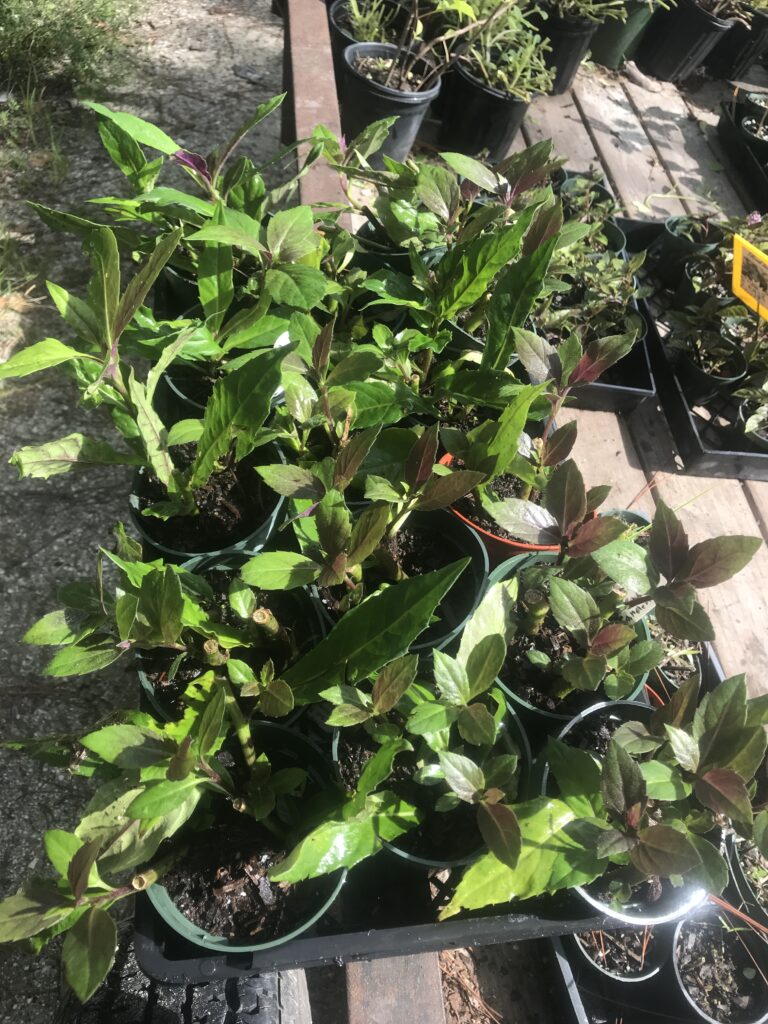S & J Nursery’s guide to Growing Okinawa Spinach
in the Northeast Florida Garden (Gynura crepioides)
Okinawan spinach has been creeping around in my garden happily for several years now and I love it. Pretty enough to be grown as an ornamental, Gynura crepiodes has beautifully ornamental dark green leaves with a purple underside and a purple color to the stem.
In our Northeast Florida gardens Gynura crepioides will make a beautiful edible ground cover. Both the leaves and new shoots are edible and quickly replace themselves after harvesting on the plant. Young tender leaves can be eaten raw in salads, juiced, or added right into your morning smoothie. Older leaves and stems can be steamed, used in a stir fry, battered and fried as tempura, added to soups and stew.https://www.youtube.com/embed/sk_shVcnmXs
Foliage, Origins, and Use of Gynura crepioides/Okinawan Spinach:
Native to Indonesia these perennial garden plants are quickly gaining popularity here for their easy care habit and delicious leaves!
The foliage should remain evergreen in all but the coldest of our Northeast Florida winter temperatures, but the plants root so readily in moist soil it is easy to ensure next years crop by taking 8 or 10 stem tip cuttings and sticking them in a pot of soil in your kitchen window till spring!
These plants are great for using anywhere you have a spot that needs filled in your traditional landscape or your edible garden. Okinawa spinach also makes perfect hanging baskets, easily lends itself to container planting to add color and texture to patios and walkways, and even grows nicely indoors in a windowsill!

Okinawan spinach is sometimes sold as cholesterol spinach, and like its close relative Gynura procumbens ( Longevity Spinach), is said to lower blood cholesterol levels.
Leaves are edible raw or cooked. young leaves are best raw for salads and smoothies and older large leaves are better when cooked. (Don’t overcook, leaves will have a tendency to turn to mush or be ‘slimy’ if overcooked, treat them as you would an herb when cooking and throw them in the pot in the last few minutes)
Planting Season for Gynura crepioides / Okinawan Spinach:
Okinawa spinach can be planted year round in our Northeast Florida garden from nursery plant starts. You can root cuttings on your existing plants easily during the warmer seasons or indoors in a sunny window.
Sun Exposure for growing Gynura crepioides / Okinawa Spinach :
Gynura crepiodes can be planted into full sun or partial shade areas of the garden.
Soil Preferences for Gynura crepioides / Okinawa Spinach the Jacksonville and St. Augustine Florida areas:
Tolerant of a wide range of soil components and conditions from sand to clay. I have an extremely sandy garden and the plants grow beautifully when generously amended at planting time with compost.
Care of Gynura crepioides / Okinawa Spinach :
Watering Your Gynura crepioides / Okinawa Spinach :
Newly planted Gynura crepioides / Okinawa Spinach will require watering daily for the first few days to a week after being transplanted from an S & J Nursery container.
Once the Okinawan spinach plants are established and growing they will require very little in the way of care from you. make sure to give them a little extra water in times of drought or when used in container plantings and hanging baskets as those tend to dry out quickly.
Mulching Your Gynura crepioides / Okinawa Spinach Plants:
For maximum growth potential, mulch plants generously, this will help conserve moisture.
Fertilizing Your Gynura crepioides / Okinawa Spinach :
Althugh Okinawan spinach is not a heavy feeder it is grown as a foliage harvest plant. If you decide to use fertilizers, a heavy nitrogen fertilizer is the way to go to promote healthy foliage growth. I have been happy with the growth I get form mine so far with just a generous helping of compost when they are planted into the ground from the S & J Nursery container and a generous layer of compost around each plant every spring before the new growth has sprouted.
For an organic approach, try fertilizing with a mixture of fish emulsions and seaweed (kelp) at one ounce each per gallon of water. Apply semi weekly as a foliar spray.
If your vegetable plants look like they could use a boost, give them a good watering with homemade compost tea as soon as the top few inches of soil around your plant is dry to the touch!
Harvesting Your Gynura crepioides / Okinawa Spinach in the Northeast Florida Vegetable Garden:
Your Gynura crepioides / Okinawa Spinach can be harvested year round. Picked leaves and stems regrow quickly so daily harvesting is possible on larger plants.

